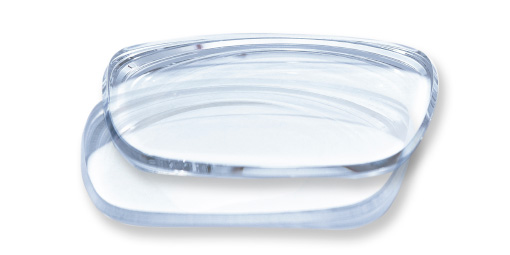Polycarbonate Eyeglass Lenses - A Safe Choice
15-03-2023
A Safe Choice, But Perhaps Not The Best Choice
Polycarbonate eyeglass lenses are the most common type of lenses sold, especially by online vendors and big box stores. Polycarbonate lenses offer many advantages. However, they may not be the best choice for everyone. It's important to consider your specific needs and preferences when choosing lens materials for your eyeglasses and it is equally important to be aware of other options available.Advantages of Polycarbonate Lenses
Polycarbonate eyeglass lenses are a type of lens material comprised of a thermoplastic polymer called polycarbonate. The material is known for its high impact resistance and lightweight properties, making it a popular choice for safety glasses, sports goggles, and eyeglasses. Polycarbonate lenses are thinner and lighter than regular plastic lenses (CR 39, Refractive Index of 1.50), making them more comfortable to wear. They also provide better protection against impacts than regular plastic lenses, making them a more suitable choice for athletes, and individuals that work in hazardous environments. In addition, polycarbonate lenses have built-in UV protection, which offers protection from the sun’s harmful UV rays, making them, a great option for those who spend a lot of time outdoors and require corrective lenses for outdoor activities.Disadvantages of Polycarbonate Lenses
While polycarbonate lenses have many advantages, there are also some disadvantages to consider when choosing it for your eyeglasses. Some potential drawbacks include:- While polycarbonate lenses are more scratch-resistant than regular plastic lenses, they are still more susceptible to scratches than some other lens materials, such as glass or Trivex.
- Polycarbonate lenses are only available in a limited range of colors and tints, which can be a drawback for people who want more customization options.
- Polycarbonate lenses can be more prone to glare and reflections, which can be distracting and affect vision in certain situations.
- Polycarbonate lenses are generally more expensive than regular plastic lenses, which can be a consideration for people on a budget.
- While polycarbonate lenses are thinner and lighter than regular plastic lenses, they may not be suitable for people with high prescriptions, as they may result in thicker, less attractive lenses.
Polycarbonate vs. Trivex Lenses
Polycarbonate and Trivex lenses are two popular choices for eyeglass lenses. While both materials offer similar benefits, there are some differences to consider when choosing between them. Here are some key differences between polycarbonate and Trivex lenses:- Trivex lenses offer better optical clarity than polycarbonate lenses, meaning they provide sharper, clearer vision.
- Both materials offer high impact resistance, but Trivex lenses are slightly more impact-resistant than polycarbonate lenses.
- Naked (i.e., without an anti-scratch lens coating), Trivex lenses are more scratch-resistant than polycarbonate lenses, making them a better choice for people who are rough on their glasses.
- Trivex lenses are slightly lighter than polycarbonate lenses, making them more comfortable to wear for long periods.
- Trivex lenses (1.53) have a slightly lower refractive index than polycarbonate lenses (1.56-1.59), requiring slight more material to refract the same amount of light as polycarbonate.
- Trivex lenses have a higher Abbe value than polycarbonate lenses, which means they are less likely to cause distortion or chromatic (i.e., color) aberrations around objects.
- Trivex lenses typically have a higher price point than polycarbonate lenses, but the difference is often nominal.
Trivex Trumps Polycarbonate Lenses
Polycarbonate and Trivex eyeglass lenses are options for those who require high-impact resistant safety glasses, need lenses less susceptible to chipping for semi-rimless frames, and/or who lead active lifestyles. When choosing between the two, it is important to consider your specific needs and preferences, as well as your budget. If you are an individual in need of protective eyewear that meets national, workplace, or sport safety standards, then polycarbonate lenses may be the only option available to you. On the other hand, if you are seeking lenses for standard daily wear, Trivex lenses should seriously be considered, as they offer superior optical performance while providing similar impact resistance and comfort to that of polycarbonate. Schedule An Appointment
Children's Glasses
Invest in your child's health and future with eyeglasses professionally custom-crafted to their individual needs and active lifestyles.

Women's Glasses
Upgrade your vision and your look with new women's eyeglass styles. Find your new vision and look at our Edmonton optical.

Men's Glasses
See your best and be your best with eyeglasses designed specifically for your work environment and lifestyle preferences.
Frequently Asked Questions
Chromatic aberration refers to the effect produced by the refraction of different wavelengths of light through slightly different angles, resulting in a failure to achieve focus. It causes colored fringes/edges around objects.
Different lens materials have different properties, such as density, index of refraction, and Abbe values. The Abbe Value is a number given to describe the amount of chromatic aberration of an eyeglass lens material. The higher the number, the less amount of aberration.
